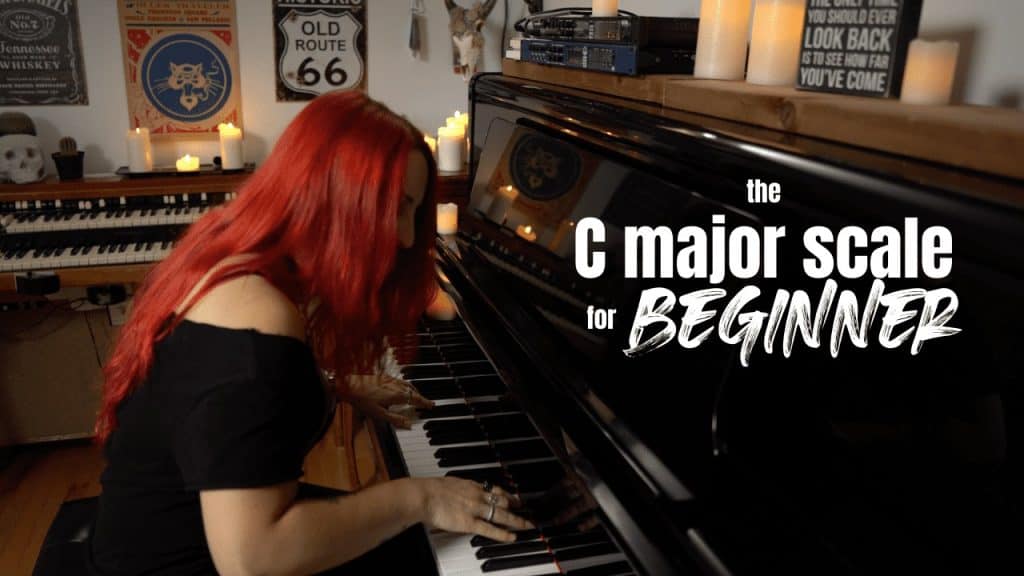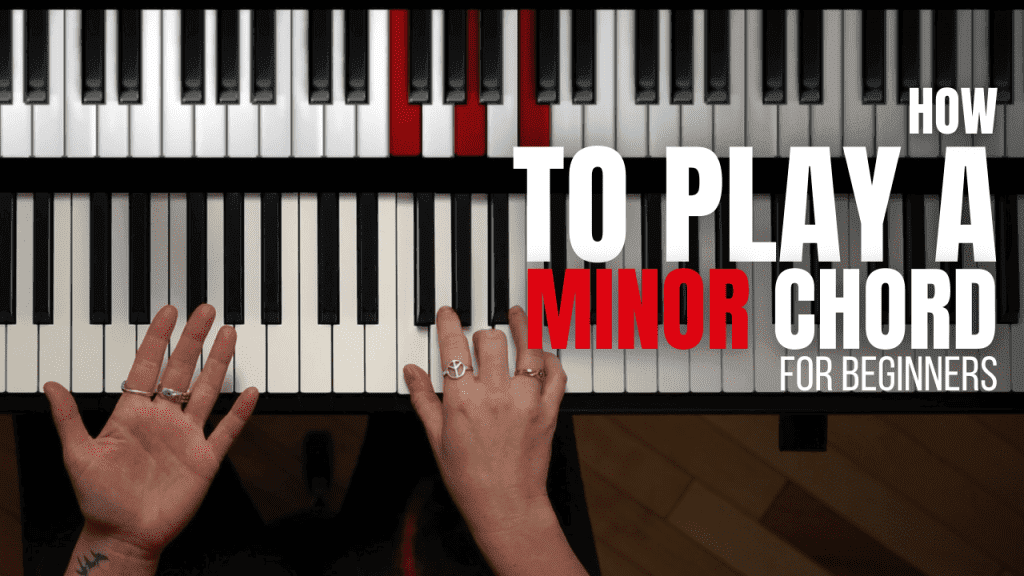4 magnifiques arrangements d'accords mineurs
4 magnifiques arrangements d'accords mineurs
MARINE LACOSTE / ACCORDS / 7 OCTOBRE 2022
4 magnifiques arrangements d'accords mineurs
MARINE LACOSTE / ACCORDS / 7 OCTOBRE 2022
In this lesson we will discover 4 voicings to spice up your regular minor chord.
The Minor Chord
The minor chord is based on the degrees 1, 3 and 5 of a minor scale. For this exercise, we will use the A minor chord. The notes of this chord are A, C and E. It is also important to know the inversions of your chord. In this case, the order of the notes of the root position is A, C and E, the order of the notes of the first inversion is C, E and A and finally, the order of the notes of the second inversion is E, A and C.
If the concept of minor chords is new to you, make sure to watch the tutorial explaining
Russell Ferrante’s Triad on Triad Approach:
Russell Ferrante, pianist and keyboardist, found a different way to explain complex chords. His concept consists of playing a triad over a different triad. For the A minor 7 chord, the A minor chord is played with the left hand and the C major chord is played with the right hand. The A minor and C major chords have two notes in common, C and E, and the G in the C major chord is what creates the sound of the minor 7. You can play with different inversions as well as choose if you want to duplicate certain notes (ex. the C note is found in the A minor chord and the C major chord) or play every note once.
Alternative #2: Minor 9
The second alternative to the regular minor chord we are learning is the A minor 9. This chord is composed of the degrees 1, 3, 5, 7 and 9. The notes of the A minor 9 chord are A, C, E, G and B. Even though the seventh is not mentioned in the name of the chord, it is still implied.
Since this chord is made up of 5 notes, we have to use both of our hands to properly voice it. There are different ways to voice this chord, you can play the degrees 1 and 5 with the left hand and the degrees 7, 9, 3 and 5 with your right hand. The order of the notes of the A minor 9 chord in this voicing is A, E (left hand), G, B C and E (right hand).
Triad on Triad Concept
The equivalent of playing a minor 9 chord is to play a C major 7 chord over an A minor chord. The left hand plays an A (the first degree of the A minor scale) and the right hand plays the C major 7 chord which is composed of the notes C, E, G and B (the degrees 3, 5, 7 and 9 of the A minor scale).
Alternative #3: Minor 11
The third alternative to a regular minor 7 chord is the minor 11 chord which consist of the degrees 1, 3, 5, 7, 9 and 11. The seventh and ninth degrees are not mentioned in the name of this chord but are implied. The notes of the A minor 11 chord are A, C, E, G, B and D.
Since this chord is made up of 6 notes, we have to use both of our hands to properly voice it. There are different ways to voice this chord, you can play the degrees 1 and 5 with your left hand and the degrees 3, 11, 7 and 9 with your right hand. The order of the notes of the A minor 11 chord are A, E (left hand), C, D, G and B (right hand).
Triad on Triad Concept
The minor 11 chord is the equivalent of playing a G major chord over an A minor chord. The left hand plays A, C, E (the degrees 1, 3 and 5 of the A minor scale) and the right hand plays G, B and D (the degrees 7, 9 and 11 of the A minor scale).
Alternative #4: Minor 9(11)
The fourth alternative to the regular minor chord is the minor 11. For this alternative we will play an open voicing.
What Are Open Voicings?
An open voicing is a voicing that has no clusters. It means that there are no notes that are very close to one another. For example, if you want to play C, D and G, the C and D are too close, so you have to change the order of the notes to C, G and D. The D will be an octave higher.
There are different ways to voice this chord. To play an open voicing, you can play the degrees 1 and 5 with your left hand and the degrees 3, 7 and 11 with your right hand. The order of the notes of the A minor 11 in this open voicing are A, E (left hand), C, G and D (right hand).
You now know 4 alternatives to playing a regular minor chord. You can practice these in all keys, chromatically, in all inversions and even play around with a melody with your right hand!
Text Transcription by Andreane Boucher
Dans cette leçon, nous allons découvrir 4 alternatives à l’accord mineur régulier.
L’accord mineur
Un accord mineur est basé sur les degrés 1, 3 et 5 d’une gamme mineure. Pour l’exercice d’aujourd’hui, nous allons utiliser l’accord de La mineur. Les notes de cet accord sont la, do et mi. Il est important de connaître les inversions des accords. Pour l’accord de La mineur, l’ordre des notes à la position fondamentale est la, do et mi. L’ordre des notes du premier renversement est do, mi et la. Puis, l’ordre des notes du deuxième renversement est mi, la et do.
Si le concept d’accords mineurs est nouveau pour toi, clique ici pour
L’approche « Triade sur triade » de Russell Ferrante
Russell Ferrante, pianiste et claviériste, explique les accords plus complexes d’une façon différente. Son approche consiste à voir les accords comme étant deux triades superposées. Par exemple, l’accord de La mineur 7 serait un mélange de l’accord de La mineur qui est joué à la main gauche et de l’accord de Do majeur qui est joué à la main droite. Les accords de La mineur et de Do majeur ont deux notes en commun, le do et le mi. La présence du sol dans l’accord de Do majeur ajoute la couleur mineur 7, puisque le sol est le degré VII de la gamme de La mineur.
Il est possible de personnaliser ce voicing en s’amusant avec différentes inversions et en choisissant quelles notes dupliquer ou non. Par exemple, le do se retrouve dans l’accord de La mineur ainsi que dans l’accord de Do majeur, c’est à nous de choisir si nous voulons le dupliquer ou le jouer juste avec une des deux mains.
Alternative #2 : Mineur 9
La seconde alternative à un accord mineur régulier est l’accord mineur 9. Cet accord est composé des degrés 1, 3, 5, 7 et 9. Les notes de l’accord de La mineur 9 sont la, do, mi, sol et si. Bien que dans le nom « mineur 9 », la septième ne soit pas mentionnée, elle est tout de même sous-entendue.
Puisque cet accord est composé de 5 notes, nous pouvons utiliser nos deux mains pour jouer celui-ci. L’accord mineur 9 peut être joué de la façon suivante : les degrés 1 et 5 avec la main gauche et les degrés 7, 9, 3 et 5 avec la main droite. Pour l’accord de La mineur 9, l’ordre des notes est la, mi (main droite), sol, si, do et mi (main droite).
Concept de triade sur triade
Un accord mineur 9 est l’équivalent de jouer un accord de Do majeur 7 en même temps qu’un accord de La mineur. La main gauche joue un la (le premier degré de la gamme mineur de La) et la main droite joue l’accord de Do majeur 7, donc do, mi, sol et si (les degrés 3, 5, 7 et 9 de la gamme de La mieur).
Alternative #3 : Mineur 11
La troisième alternative à l’accord mineur régulier est l’accord mineur 11. Celle-ci est composée des degrés 1, 3, 5, 7, 9 et 11 de la gamme mineure. La septième ainsi que la neuvième ne sont pas incluses dans le nom de l’accord mais elles sont sous-entendues. Les notes de l’accord de La mineur 11 sont la, do, mi, sol, si et ré.
Puisque cet accord comporte six notes, nous devons utiliser nos deux mains pour le jouer. L’accord mineur 11 peut être joué de la façon suivante : les degrés 1 et 5 à la main gauche ainsi que les degrés 3, 11, 7 et 9 à la main droite. L’ordre des notes de l’accord de La mineur 11 en utilisant ce voicing sera la et mi à la main gauche et do, ré, sol et si à la main droite.
Concept de triade sur triade
Un accord de La mineur 11 est l’équivalent de jouer un accord de Sol majeur en même temps qu’un accord de La mineur. La main gauche joue la, do et mi (les degrés 1, 3 et 5 de la gamme de La mineur) et la main droite joue sol, si et ré (les degrés 7, 9 et 11 de la gamme de La mineur).
Alternative #4 : Mineur 9(11)
La quatrième alternative à l’accord mineur régulier est l’accord mineur 11. Pour cet accord, nous allons le jouer en « open voicing ».
Qu’est-ce qu’un « open voicing »?
Un open voicing est une succession de notes qui ne sont pas collées. Par exemple, si nous voulons jouer les notes do, ré et sol, sans avoir de notes trop rapprochées (do et ré), nous devons changer l’ordre des notes pour celui-ci : do, sol et ré, le ré sera donc une octave plus haut.
L’accord mineur 9 (11) en open voicing peut être joué de la façon suivante : les degrés 1 et 5 à la main gauche et les degrés 3, 7 et 9 à la main droite. L’ordre des notes de l’accord de La mineur 9 (11) joué de cette façon sera la et mi à la main droite ainsi que do, sol et ré à la main droite.
Ces quatre alternatives sont à pratiquer dans toutes les tonalités ainsi que dans toutes les inversions. Vous pouvez également vous amuser à jouer une mélodie à la main droite et les accords à la main gauche. Bonne pratique!
Transcription par Andréane Boucher
Partager:
Fondatrice de Online Rock Lessons, Marine est claviériste pour Uncle Kracker, Corey Hart et Highway Hunters.
Avec plus de 20 ans d'expérience dans le show business, Marine lance la première école de piano en ligne Canadienne dédiée aux amoureux du rock et du blues.
Plus de leçons










